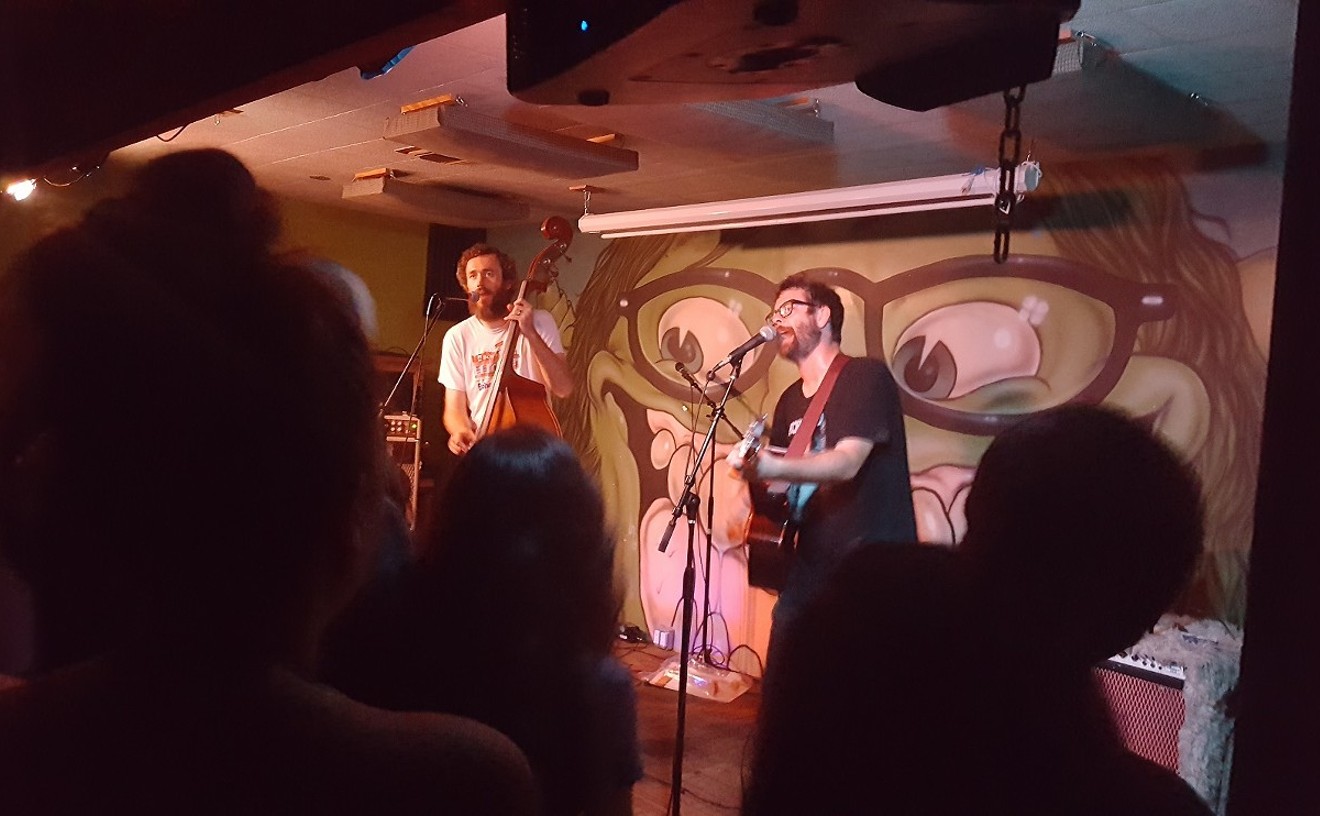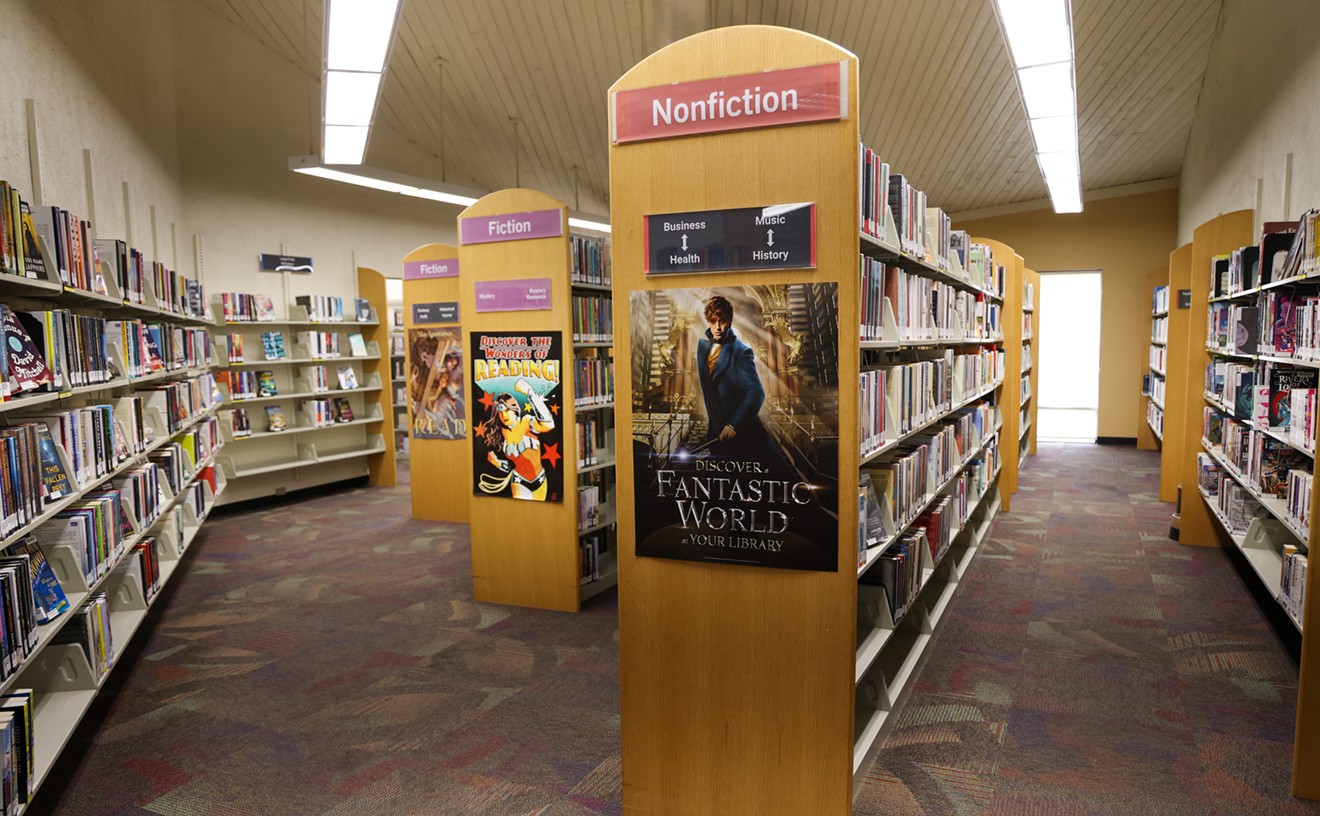But a closer look at Manch's charmingly naive mixed-textile pieces reveals themes deeper than nostalgia and prettiness. There's a playful complexity to Manch's worked-over finery. Out of one, originally embellished with a dainty woman's parasol sewn into one corner, an embroidered portrait of a hip-hop gangsta glowers arrogantly. In another — a prissy, pre-printed scarf — Manch has brought her love of blending the old with the new by stitching the title of a relatively obscure Kate Bush tune onto an old woman's purse accessory.
Born and raised in Phoenix, the 29-year-old artist moved to Seattle six years ago after attending ASU; she earned a graduate degree in photography from the University of Washington.
"Even though I studied photography, my ideas always leaned toward things that wanted fabric and textiles," Manch says. "I'd done embroidery as a child — my mother taught me how — and in college, when I wasn't in the darkroom, I'd be doing embroidery because it was something I enjoyed."
Manch began using vintage hankies because, she says, "I had a ton of them. When my grandma passed away, I inherited all of hers. I liked that connection, the immediate, emotional reference to my own history, and the way that, when people saw the work, they had the same connection. They'd say to me, 'Oh, my grandmother carried those, too.' If I started with a plain old blank canvas, that reference wouldn't be there, either for me or the person seeing (my art)."
So handkerchiefs became Manch's canvas, in the beginning for word portraits of friends and family. She'd interview them about the mundanities of their lives — what they liked to eat, recent wounds — then select a single quote from the interview and embroider it onto one from her pile of hankies. Pesto and Paper Cut commemorates one woman's favorite food and another's work injury in quotes embroidered onto a round, chocolate-brown woman's handkerchief.
Later, Manch moved onto wider concepts. Dictionary Page: A is part of a newer series of 26 handkerchiefs, each depicting the first dictionary page for each letter of the alphabet.
But not any old snot rag will do. "Only certain kinds work," Manch insists. "I need handkerchiefs with a tight enough weave. After I used up the ones my grandma left me, I started buying them on eBay. But ever since I started showing my work, I've been getting donations. I like that, because people find them out in the world, and they think of me, or they bring me ones that their grandmother left them, and I'm able to make that piece of them into part of another, ongoing story."
These pieces of other people eventually became the repository for Manch's most popular works, which depict lyrics from popular songs embroidered onto the handkerchiefs. Manch draws us in with bits of rhyme that we recognize, allowing us to make a connection between our own history with the song being quoted and the familiar object onto which its lyric has been sewn.
There's a certain sly humor behind these musical references. For one of the pieces, Manch surrounded an embroidered lyric from Dolly Parton's oft-covered "Jolene" ("Jolene, Jolene, Jolene, Jolene/I'm begging of you please don't take my man") with glass beads and sequins. It's a lyric that's both tragic (because of its content) and funny (because its repetitive, jangly chorus, sung by Parton back when she dressed like a big-haired bimbo, comes instantly to mind when we see this piece).
But Manch is looking for more than punchlines in her work. "I love the simplicity of Dolly's lyrics," she says of the Parton piece. "I'm always looking for songs that tell a story in five or 10 words, so I don't have to transcribe a whole verse in embroidery."
(An exception is the striking, hand-dyed God Only Knows, which Manch has stitched with most of the chorus from the famous Beach Boys tune in bold, white block letters onto a sullen, brown-black hanky.)
The Dolly Parton piece might hang in the same show as, say, a piece onto which a snippet of a Jennifer Lopez song has been sewn. It's in keeping with Manch's juxtaposition of something old with something new; her desire to fuse oddly matched ideas, like pop music and old ladies' needlework hankies. Or hip-hop music pioneers and geology, a recurring theme in Manch's work that draws together these two disparate themes by depicting hip-hop artists' love of "bling." The rap stars' ears and necks drip with faux geological gems in Manch's needle-and-thread portraits.
In "Sampling," her new show at downtown's Practical Art gallery, a series of embroidered daguerreotypes called The Producers depicts hip-hop record producers in ornate, graceful frames. Rick Rubin is a dead-on portrait of the renowned Run-DMC producer that's bordered by the hankie's tight, graceful original embroidery. In RZA, the founder of the Wu-Tang Clan glowers alongside the graceful parasol of the hanky's original design.
Despite her love of hip-hop and pop lyrics, Manch keeps returning to her roots, depicting her family in abstractions of brightly colored thread. Some have sports themes: In Hometeam, a Buffalo Bills football helmet (Manch's family hails originally from Buffalo) has been stitched into the center of a crisp, white handkerchief alongside a sprig of bright, similarly colored pansies. In Dorothy Manch, a wee, embroidered likeness of a football pendant necklace her grandmother used to wear dangles from a stitched chain on a delicate, floral print hanky.
For Manch, hankies are only for wrapping around her love of junk jewelry, of pop music producers. Her work is nothing to sneeze at. "I can't imagine using a handkerchief for its intended purpose," she laughs. "They're lovely objects, and to blow my nose into one? I couldn't do it."










